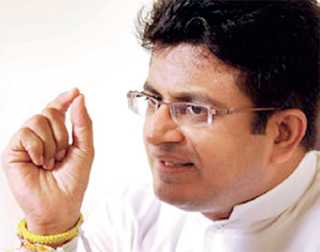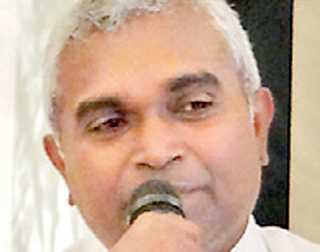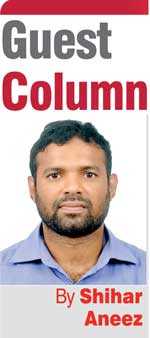Sunday Apr 20, 2025
Sunday Apr 20, 2025
Tuesday, 8 December 2020 02:26 - - {{hitsCtrl.values.hits}}

Energy Minister Udaya Gammanpila

Dr. Thilak Siyambalapitiya

LIOC Managing Director Manoj Gupta
When global oil benchmark Brent crude plunged to its cheapest level in almost 18 years in March this year due to the coronavirus shutdown, some Sri Lankan officials suddenly wanted to use the opportune time to store fuel in the country’s China Bay oil tank farm at a lower cost.
But unfortunately the tanks were not ready to store crude products and were not owned by the Sri Lankan Government.
Sri Lanka has 99 oil tanks built under British colonial rule before the Second World War, each with 12,100 metric ton capacity in the eastern port city of Trincomalee. Only 15 tanks in the lower tank farm are in operation and used mainly by Lanka Indian Oil Corporation (LIOC), a subsidiary of State-run Indian Oil Corporation.
The remaining 84 tanks in the upper tank farm are unutilised and need refurbishment if they are to be used. That refurbishment will need more than one year to accomplish and each tank needs an investment of around $ 2 million, industry experts say.
Unfortunately, Sri Lanka does not have the money to refurbish and more importantly to have control over this valuable resource which could be developed as one of South Asia’s energy hubs with 1.2 million metric tons of storage capacity, which is in excess of domestic requirement.
At present, the entire capacity of fuel storage in the country is adequate for diesel requirement for 27 days, petrol for 24 days, kerosene for 29 days and aviation fuel for 40 days, a Parliamentary report says. It also says adequate fuel storage facilities should be maintained in Sri Lanka to do away with economic and other disadvantages resulting from unnecessary emergency purchases.
The China Bay tank farm is located next to the Trincomalee Port, the fifth largest natural harbour in the world and one of the most strategic locations in the world. After the British used the tank farm during the Second World War, many international powers have been eying Trincomalee Port and adjoining strategic assets.
Sri Lanka’s messed up foreign policies led international powers to compete for this strategic location in the early 1980s. These international powers are well aware of the importance of this strategic port, more so than Sri Lankan leaders.
Indian concerns
When J.R. Jayewardene’s administration got close to the United States, after his massive election victory in 1977, India feared that Sri Lanka’s first Executive President could give the Trincomalee Port to be used as a naval base for the US military. This was the time when India and the US were engaged in the cold war because of the US alliance with China and Pakistan.
Jayewardene had earlier agreed to give the Trincomalee tank farm development project to India because of India’s fear that the original bidder at that time, a Singapore firm, had links to the US.
Jayewardene’s decision in 1981 to lift the nine-year-old ban on foreign warships in the Trincomalee harbour was seen as a major threat to India’s hegemony in the region, particularly because the US was the first to send warships to the Trincomalee Port for refuelling.
India feared that the Trincomalee harbour would be covertly converted into a US naval base if it did not put pressure on Sri Lanka to give up the Singapore firm’s offer.
This, along with the J.R. administration’s response to 1983 ethnic clashes with attacks over minority Tamils and South Indian Tamil Nadu’s agitation, led Indira Gandhi’s administration to train Sri Lankan Tamil youths in South India.
This is how the Liberation Tigers of Tamil Eelam (LTTE) received foreign training in India. However, India turned around gradually after its own Prime Minister Rajiv Gandhi was assassinated in an LTTE suicide bomb in 1991 and later helped the Government of President Mahinda Rajapaksa from 2005-2009 to defeat the ruthless Tamil Tiger separatists.
It took 16 years for Sri Lanka to give the China Bay oil tank farm to State-run Indian Oil Corporation through a Government-to-Government deal between the two neighbours which was originally discussed in the 1987 Indo-Lanka Accord.
Indian Prime Minister Rajiv Gandhi’s letter, which is included as an annexure of the accord, states: “The work of restoring and operating Trincomalee Oil Tank farm will be undertaken by a joint venture between India and Sri Lanka.” It has been more than 33 years since the accord was signed and the restoration has not been completed and only 15% of the tanks are in operation now.
During the internationally-hailed peace process between the Sri Lankan Government and LTTE, then Prime Minister Ranil Wickremesinghe’s Government finally signed the deal with the Indian Government for the China Bay oil tank farm in February 2003.
With the uncertainty of a possible war with the LTTE, which was in a strong position, the Sri Lankan Government could not bargain for a better price for the deal in 2003, officials who were aware of the negotiations say.
Incomplete lease deal
The 2003 agreement was proposed for the State-run Ceylon Petroleum Corporation (CPC) to sign the lease agreement with the IOC within six months and transfer the 850-acre land along with the tanks to the Indian oil giant for 35 years at an annual payment of $ 99,000 to the Sri Lankan Treasury and $ 1,000 to the CPC by the LIOC.
However, two top retired CPC officials said the 850-acre China Bay land was never transferred to debt-ridden CPC from the Government since it was acquired from the British in 1957 by Sirimavo Bandaranaike’s Government with the then Foreign Secretary N.Q. Dias leading the acquisition deal for 250,000 sterling pounds. The CPC was only established in 1961.
And the proposed lease agreement as stipulated in the deal was never signed within six months.
“The issue with the lease agreement is that the CPC cannot transfer the land to LIOC because it does not own that land,” one of the retired CPC officials said, asking not to be named. “So the CPC can never sign the lease agreement for a property it does not own.”
Hence the lease agreement between CPC and LIOC is incomplete.
Under the last Government, the Parliamentary Committee on Public Enterprises (COPE) headed by Marxist Janatha Vimukthi Peremuna (JVP) MP Sunil Handunnetti recommended that the Government take over the Trincomalee oil tanks from the LIOC because no lease agreement was signed since they were handed over to the LIOC in 2003.
For the goodwill of diplomatic relations with India, none of the Sri Lankan governments has either challenged the lease agreement legally or demanded the LIOC to return the tank farm, a senior Government official said, asking not to be named.
The LIOC also for its part has never defaulted on the stipulated official annual payment of $ 100,000 since the deal was signed.
Only 15 tanks have been refurbished out of the 99 in the last 18 years since the deal was signed. Successive governments since the end of the war have been discussing with the LIOC and Indian Government officials to take back some of the tanks to be refurbished and operated under loss-making CPC as well as under Joint Venture, Government officials say.
South Asia’s energy hub
When Indian Prime Minister Narendra Modi visited Colombo in March 2015 soon after an Indian-friendly Government was elected to rule Sri Lanka, he promised to establish South Asia’s energy hub in Trincomalee.
After the discussion with the then Sri Lankan Leader Maithripala Sirisena, who had all the backing of India in 2015, Modi made this announcement and said both South Asian neighbours would jointly establish this hub and the plan was to do it through the respective State-owned CPC and IOC.
But the Trincomalee oil tank farm remains the same almost six years after Modi’s pledge. The tanks are idling without being used and time to time both India and Sri Lanka have tried to expedite the Joint Venture in their own way though the result has been the same: nothing changes.
Nothing has changed except some agitation and protests by CPC trade unions and politicians who are accusing the LIOC of wasting one of Sri Lanka’s most valuable, if not the topmost valuable, resources next to one of the world’s best natural harbours.
When the last Government tried to iron out the issues with taking back 10 tanks for the exclusive usage of CPC and some others to be operated under Joint Venture, then Oil Minister Chandima Weerakkody in 2017 met strong opposition from the CPC Trade Union, which said such a Joint Venture would give the control of price determination of Sri Lankan fuels to India.
Long delays
The oil tank project is one of the key deals via which some Sri Lankan politicians try to instil anti-Indian sentiment in the country. It is a proven fact that anti-Indian sentiment can easily be transformed into votes in elections.
And these political leaders say, unlike Chinese projects, India always locks valuable assets through agreements or long-dragged-out negotiations and they never put them into use for economically viable projects.
Apart from oil tanks, long-dragged-out negotiations on Sampur Coal Power Plant, Mattala Airport, and currently the Colombo Port’s Eastern Container Terminal are also cited as examples of how India delays decision making on strategic national assets. Indian deals on Sampur Coal Power Plant and Mattala Airport were limited only to negotiations.
However, Indian officials vehemently reject allegations of the subcontinent dragging its feet to delay projects.
“India has been waiting for a proper Joint Venture proposal from Sri Lanka for the refurbishment of oil tanks, but there have been long delays. You should also understand that India can’t take a decision alone in this,” an Indian official who is aware of the negotiations between the two South Asian nations said.
“More than viable business proposals, local political issues are also looked into in the negotiations and these are also reasons for the delay. Also India is a democratic nation where its decision making is done through a proper bureaucratic process which also could make some delay,” the official said.
Many senior Sri Lankan Government officials did not want to comment on the oil tank deal because of the sensitivity. However, a few top senior officials said the deal was unfortunate.
“India needs a strategic location like Trincomalee when it becomes a world super power in the future and it has locked the resource through the agreement. It neither wants to develop it nor the tanks to be developed by another foreign country,” one senior official said.
“Sri Lankan leaders should have taken a cue from Singapore’s Lee Kuan Yew. Singapore initially only had oil tanks which were given to foreign investors for trading. We have missed this opportunity, though it is still not too late.”
New start, positive approach
There has been a range of proposals discussed with the LIOC on the return of oil tanks.
One proposal was for CPC to operate 10 tanks separately on its own and another 15 tanks under CPC/IOC Joint Venture.
There was another proposal to operate only 15 tanks under the Joint Venture. And a Cabinet decision in the last Government to take over 16 tanks was not carried out due to the CPC Trade Union’s opposition after some CPC officials who visited the tank farm charged they had been prevented from entering the tank farm.
And since taking over, Energy Minister Udaya Gammanpila has been in the forefront to take over some tanks to CPC. He was quoted last month in local papers that there had been three rounds of discussions and he was optimistic of the outcome without elaborating on the discussions.
LIOC Managing Director Manoj Gupta says the Indian company is ready to contribute to the development and refurbishment of unused upper tanks.
“LIOC has undertaken significant huge investments in the oil tank farm till now, despite the precarious and challenging security situation that existed in the beginning. The repair and refurbishment of tankages, pipelines, jetty, etc., and the creation of required facilities since then have enabled the current levels of utilisation,” he said in statement when asked about the allegations levelled by some Sri Lankans on the Indian company not doing anything after the agreement.
Construction of six tanks began in October 2019 and the ground-breaking ceremony was recently held in the presence of Energy Minister Udaya Gammanpila for the construction of the remaining three tanks at Kolonnawa. “These storage tanks will…. augment Sri Lanka’s storage capacity to cover 20-day petroleum product requirement in the country from the 13-day capacity currently.”
He also said the utilisation of the tanks in the upper tank farm following repair/refurbishment would be mutually-beneficial to both Sri Lanka and India.
“Refurbishing 84 tanks from the Second World War era will involve considerable investment and any such arrangement will have to be agreed on between the two governments. LIOC has an open mind and constructive approach to explore long-term solutions that benefit all stakeholders.
“We are optimistic that the long-pending issue shall get resolved with the proactive concerned approach of the existing Government of Sri Lanka and this would further strengthen the bilateral relations amongst the two countries.”
Concerns remain
Dr. Thilak Siyambalapitiya, an energy expert who chaired Sri Lanka’s Energy Policy Committee, says it is difficult to quantify the opportunity cost of not furbishing all the oil tanks in China Bay.
“If all the tanks are refurbished and in use, Sri Lanka can strategically manage the energy and plan for the future. That opportunity is lost,” he said, adding that the country’s energy policy had only become a beautiful document and not in practice.
“We need to have strategic oil reserves and these tanks could be part of it to ensure the energy security of the country. When reserves are down, it should be transparently managed with all the costs accounted for and the energy policy says the country should have energy storage for at least 30 days.”
The long delays are now hurting the country’s economy, which is already in huge debt.
Some retired CPC officials believe that there was no genuine effort from both India and Sri Lanka to restore and operate all 99 tanks in Trincomalee though the signed agreement says so.
“If Sri Lanka wants the tanks to be refurbished and used, the Government could have transferred the land, asked CPC to sign the lease agreement with the LIOC and start the work. And similarly, if India really wants to, it can push the Sri Lankan Government. But neither of this has happened,” the retired CPC official said.

Trincomalee oil tanks – Pic courtesy www.dailymirror.lk
[The writer is former Reuters Economic Reporter for Sri Lanka and the current Head of Training at the Centre for Investigative Reporting (CIR) Sri Lanka. He can be reached at [email protected] or via twitter @shiharaneez]
Discover Kapruka, the leading online shopping platform in Sri Lanka, where you can conveniently send Gifts and Flowers to your loved ones for any event including Valentine ’s Day. Explore a wide range of popular Shopping Categories on Kapruka, including Toys, Groceries, Electronics, Birthday Cakes, Fruits, Chocolates, Flower Bouquets, Clothing, Watches, Lingerie, Gift Sets and Jewellery. Also if you’re interested in selling with Kapruka, Partner Central by Kapruka is the best solution to start with. Moreover, through Kapruka Global Shop, you can also enjoy the convenience of purchasing products from renowned platforms like Amazon and eBay and have them delivered to Sri Lanka.
Discover Kapruka, the leading online shopping platform in Sri Lanka, where you can conveniently send Gifts and Flowers to your loved ones for any event including Valentine ’s Day. Explore a wide range of popular Shopping Categories on Kapruka, including Toys, Groceries, Electronics, Birthday Cakes, Fruits, Chocolates, Flower Bouquets, Clothing, Watches, Lingerie, Gift Sets and Jewellery. Also if you’re interested in selling with Kapruka, Partner Central by Kapruka is the best solution to start with. Moreover, through Kapruka Global Shop, you can also enjoy the convenience of purchasing products from renowned platforms like Amazon and eBay and have them delivered to Sri Lanka.